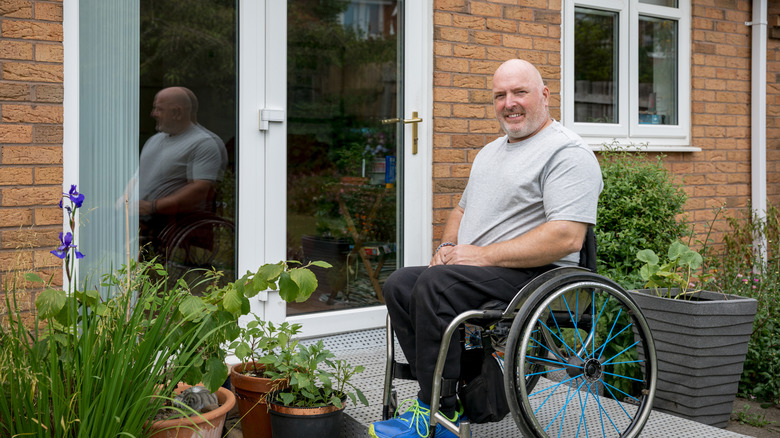Retirement Planning Tips That Also Boost Longevity, According To Experts
Planning for retirement beyond just basic food, clothing, and shelter needs is essential since your retirement lifestyle may ultimately determine your retirement success. Healthcare is often the elephant in the room when it comes to retirement planning, but this can both boost your financial retirement plan and, hopefully, your longevity. While, as per a study by RBC Wealth Management, 80% of Americans surveyed noted the cost of healthcare in retirement as a major concern, as high as 44% admitted that they've not included the potential cost of healthcare into their financial planning. People surveyed believed $2,700 per year was adequate for their needs as they age, however, as per Fidelity Investments annual Retiree Health Care Cost Estimate report, on average, a 65-year-old retiree should expect to spend as much $172,500 on healthcare over the course of their retirement.
When you retire can raise the possibility of you running out of money in retirement, but so can the unexpected and unplanned cost of medical expenses. For instance, as per SeniorLiving.org, the median cost of assisted living as of October 2025 is around $73,548 annually, with states like Alaska, Connecticut, and Delaware cresting easily over the $100,000 mark.
Make more money before you retire
One thing you can do to protect retirement savings and your longevity is to make more money throughout your lifetime. While easier said than done, there are actionable steps you can take to do just that, and you don't need an amount that allows you to retire rich in order to do it. As per a June 2025 release of a study by The Senior Citizen's League, two-thirds of seniors surveyed believed their Social Security benefits were too low and that COLA did not keep up with the rising cost of inflation. That's not just bad for your finances in the long run, but according to the National Council on Aging (NCOA), can have a direct impact on your longevity. Mortality rates double amongst seniors in the bottom 60% of wealth versus seniors in the top 20%. Seniors in the bottom 20% of wealth died an average nine years earlier than seniors in the top 20%.
Most of the highest-paying jobs in the U.S. require higher education, which is a journey most people begin in their younger years. While a degree gives you a leg up on the competition and can undoubtedly raise your earning potential, there are a few jobs that pay well without a college degree, requiring a minimal investment of money and time. That said, you may already be on track to earn more where you work. Here's how to talk to your employer about getting a raise.
Plan for lower mobility and home upgrades
As you age, the potential for limited mobility to throw a wrench into your retirement plans increases, particularly if you fail to plan for it. The cost of aging in place for seniors who need to modify their homes — think stair lifts, walk-in showers and bathtubs, accessibility ramps and wider doorways — can be affected by where you live, the amount of work required, cost of materials and layout of your home. For instance, as per Homeguide, the installation of an accessibility ramp for a wheelchair could cost anywhere from $1,000 to $6,000 for a permanent installation, with the average cost of a bathroom modification, according to Matin Real Estate, rising as high as $25,000.
Acknowledging the possibility of these expenses and costing them into your retirement planning earlier can better prepare you for them, as can having a decent emergency fund. There is also financial help supported by the Americans With Disabilities Act (ADA) that can help with home modification costs. Federal grants like the Single Family Housing Repair Loans & Grants program offer loans of up to $40,000 "to repair, improve or modernize homes or remove health and safety hazards," and up to $10,000 in grants toward the same purpose. Home modifications are one of the best ways to use a military discount according to the U.S. Department of Veteran Affairs, thanks Special Home Adaptation (SAH) and Specially Adapted Housing (SAH) grants offering up to $24,405 and $121,812 respectively.
Have a community
A six-year study conducted by the National Poll on Healthy Aging via the University of Michigan Michigan Medicine found 33% of older adults in 2024 experienced loneliness or social isolation. This is significant for your wallet since this can lead to cognitive decline, heart disease, or even mortality in older populations. According to a Place for Mom, the cost of 24-hour memory care can climb as high as $24,024 per month, with 44 hours of memory care per week adding up to around $6,292 per month. As such, community isn't just essential to your mental and physical health, but also to your retirement savings.
According to the American Senior's Housing Association (ASHA) via SeniorStar, there are financial advantages as well as health benefits to living in a retirement community versus aging at home. As per the ASHA study, the average cost of independent living is actually more affordable than aging at home. For instance, this Florida community is one of the best places to retire if you don't have savings, and is demonstrative of the importance and benefits — where both financial and physical longevity are concerned — of having a community. Just be sure to do your research so you don't end up looking at overpriced retirement communities that will only diminish your retirement savings.
Live where your money takes your further
According to the Social Security Administration Elder Index via AARP, there are 10 states where the average Social Security retirement benefit covers anywhere from 84% to almost 91% of basic monthly expenses. In order from lowest to highest percentage of monthly coverage, they are North Carolina, Arizona, Delaware, Michigan, Iowa, South Carolina, Tennessee, Alabama, West Virginia, and Indiana. Within some of these states, you'll find cities where retirees can live on Social Security alone, which makes retirement planning for longevity's sake a lot easier.
This matters because, as demonstrated by Urban Institute data covering 2000 to 2023, 21% of seniors 75 years old and over spent over 50% of their income on housing costs in 2023. For those 65 to 74 years old, it was 17%. A trifecta of lower housing stock, affordability and access to housing have only exacerbated the problem. Over the past 20 years, the amount of seniors spending over half their income on housing has grown from 5.2 million to 11.7 million according to the Urban Institute's American Community Survey. That's also led to a higher share of unhoused seniors, with the percentage of seniors experiencing homelessness rising 37% between 2019 and 2022. So common sense dictates, if planning for retirement with longevity in mind, stay away from the most expensive cities to buy a house in the U.S., and instead focus on where your money will take you further.
Insure your retirement
While there are a number of insurance products that aren't worth your money, long-term care insurance may not be one of them. According to the 2024 Genworth Cost of Care study, the national median cost of in-home care worked out to $77,792 per year, or around $6,483 per month. The national median cost of 24-hour nursing home care was an even steeper $127,750 per year. At roughly $10,646 per month, it's important to know that long-term care in a nursing home is generally one of those costs that Medicare won't cover for seniors. Along with longevity, comes the possibility of illnesses that can not only drastically impair lifestyle, mobility, or cognitive ability, but also, your retirement savings. Like all insurance plans, it's up to you to ensure that your policy covers all the bases as not all insurance products include long-term care either. CNBC compiled a helpful list of the best long-term care insurance companies for November 2025, just beware that some have age limits of between 69 and 79 years old.
Although Medicaid may offer a lifeline if you qualify for aid — it's one of the key differences between Medicare and Medicaid — even in those circumstances, the long term care nursing home must be willing to accept Medicaid as a first payer. As per a May 2025 release by the Kaiser Family Foundation (KFF), Medicaid only covered around 44% of long-term nursing care costs in 2023.
Downsize your vehicle ownership
It may not seem relative to longevity, financial or otherwise, especially considering the cost of car insurance in your retirement years, but doing this can save you money and might add years to your life. According to the U.S. Centers for Disease Control and Prevention (CDC) report released January 2025, over 740 older adults are injured in car accidents every year, and of those people, 25 don't survive. Statistically, people over 70 years old have lower crash survival rates per 1,000 crashes than drivers 35 to 54 years old. That's a direct correlation where longevity is concerned, especially if you own more than one vehicle in your household.
If that's not enough of a reason to sell a second vehicle before retirement, perhaps the thought of it costing you double the money in fuel and maintenance,along with possibly shortening your lifespan, might. According to Consumer Affairs, the average cost of maintaining a vehicle in the U.S. is around $900 per year. Where repairs are concerned, something like axle repair could cost you $250, while something more complex like an engine replacement or electric vehicle battery replacement could cost you in the ballpark of $10,000 to $18,000, respectively. According to Mach 1 Services, the average driver spends around $2,000 per year on fuel, with variations depending on your state and city. Ditch one of your vehicles and turn that expense into savings. Better yet, put the money into investment opportunities that make better financial sense for retirees.






